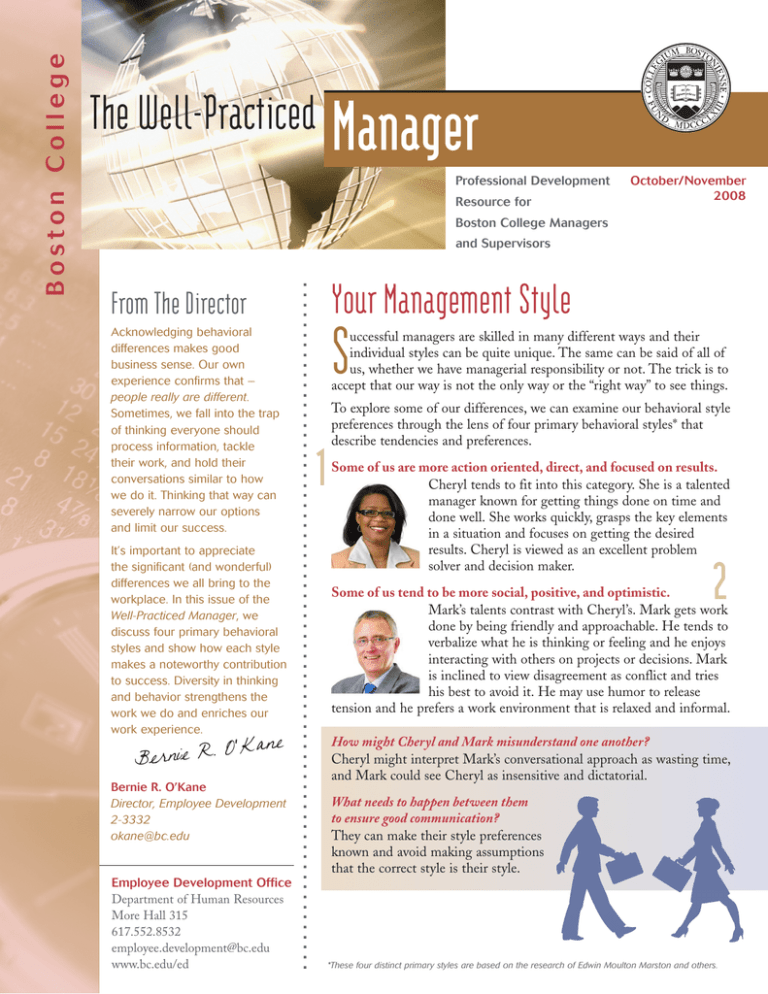Manager S The Well-Practiced
advertisement

Boston College The Well-Practiced Manager Professional Development Resource for October/November 2008 Boston College Managers and Supervisors ■ From The Director Acknowledging behavioral differences makes good business sense. Our own experience confirms that – people really are different. Sometimes, we fall into the trap of thinking everyone should process information, tackle their work, and hold their conversations similar to how we do it. Thinking that way can severely narrow our options and limit our success. It’s important to appreciate the significant (and wonderful) differences we all bring to the workplace. In this issue of the Well-Practiced Manager, we discuss four primary behavioral styles and show how each style makes a noteworthy contribution to success. Diversity in thinking and behavior strengthens the work we do and enriches our work experience. O’Kane Bernie R. Bernie R. O’Kane Director, Employee Development 2-3332 okane@bc.edu ■ ■ ■ S uccessful managers are skilled in many different ways and their individual styles can be quite unique. The same can be said of all of us, whether we have managerial responsibility or not. The trick is to accept that our way is not the only way or the “right way” to see things. ■ ■ ■ ■ ■ ■ ■ ■ ■ ■ ■ ■ ■ ■ ■ ■ ■ ■ ■ ■ ■ ■ ■ ■ ■ ■ ■ ■ ■ ■ ■ ■ ■ ■ ■ ■ ■ ■ ■ 1 To explore some of our differences, we can examine our behavioral style preferences through the lens of four primary behavioral styles* that describe tendencies and preferences. Some of us are more action oriented, direct, and focused on results. Cheryl tends to fit into this category. She is a talented manager known for getting things done on time and done well. She works quickly, grasps the key elements in a situation and focuses on getting the desired results. Cheryl is viewed as an excellent problem solver and decision maker. 2 Some of us tend to be more social, positive, and optimistic. Mark’s talents contrast with Cheryl’s. Mark gets work done by being friendly and approachable. He tends to verbalize what he is thinking or feeling and he enjoys interacting with others on projects or decisions. Mark is inclined to view disagreement as conflict and tries his best to avoid it. He may use humor to release tension and he prefers a work environment that is relaxed and informal. ■ ■ ■ ■ ■ ■ How might Cheryl and Mark misunderstand one another? Cheryl might interpret Mark’s conversational approach as wasting time, and Mark could see Cheryl as insensitive and dictatorial. ■ ■ ■ ■ ■ ■ ■ ■ ■ Employee Development Office Department of Human Resources More Hall 315 617.552.8532 employee.development@bc.edu www.bc.edu/ed Your Management Style ■ ■ What needs to happen between them to ensure good communication? They can make their style preferences known and avoid making assumptions that the correct style is their style. ■ ■ ■ ■ ■ ■ ■ ■ ■ *These four distinct primary styles are based on the research of Edwin Moulton Marston and others. Here are two more primary behavioral styles: Explain Your Style Take pride in who you are and how you tend to think. Interject some illustrative phrases about your style into everyday conversations: 1. “My tendency is to see the big picture…” 2. “How I approach this situation is to…” 3. “In contrast with that view, I believe we should…” 4. “I need to do some thinking before I support that recommendation…” 5. “I’d like to revisit this issue from the perspective of employee morale…” 6. “I need to be reassured that standards are being met…” 7. “I’m interested in the results; I rely on you for the details…” 8. “I’m reluctant to move quickly on this until we are certain…” 9. “My preference is always to involve people in important decisions like this…” 10.“I want more conversation so I fully understand your plan…” 4 3 Some of us may prefer a steady, supportive, cooperative role. Dave’s talents tend toward a behavioral style quite different from Cheryl and Mark. Dave’s approach to work is to be helpful and cooperative. He is viewed by others as fair and reasonable – and a peacemaker. Dave works best in an orderly environment where predictability, teamwork, collaboration, and clear goals are provided. He tends to avoid rushing into anything new and likes to make changes slowly. Some of us tend to uphold high standards, quality, and accuracy. Barbara’s talents illustrate the fourth primary behavioral style. Barbara’s tendency is to be thorough and methodical. She prefers logical, systematic approaches and a calm, business-like atmosphere. Barbara works very well when responsibility and expectations are clearly defined. She is a thinker, always seeking new ways to improve the quality of her work. How might Dave and Barbara misunderstand one another? Dave might interpret Barbara’s behavior to be unfriendly and her standards to be unachievable. And, Barbara could think Dave is making too many compromises and settling for less than the best work product. What needs to happen between them to ensure good communication? The same two strategies suggested for Cheryl and Mark: They can make their style preferences known and avoid making assumptions that the correct style is their style. On a day-to-day basis, understanding the four primary styles described above will open new avenues to you for connecting more effectively with others. We can’t take the risk of expecting others to be mind readers about our own needs and preferences, nor can we afford the risk of guessing what our co-workers expect from us. Appreciate Others’ Styles ☞ To interact successfully with someone who is action oriented, direct, and focused on results, be succinct in your communication. Don’t confuse the issue with details. Autonomy is usually very important to people with this primary style. Show your own competence and be confident. ☞ To interact successfully with someone who tends to be social, positive, and optimistic, let them talk. Be informal and relaxed. Typically, socializing is very important to people with this primary style. Provide written details for them and rely on conversation for your interactions. ☞ To interact successfully with someone who prefers a steady, supportive, cooperative role, be measured and collaborative in your approach. Consistency is most often very important to people with this primary style. Explain how things need to be done and let them adapt slowly to change. ☞ To interact successfully with someone who likes to uphold high Editorial Services provided by Nancy Sartanowicz, Workplace Strategies, www.yourstrategies.com Graphic Design by Tania Fine Helhoski, BirdDesign, www.birddesignstudio.com standards, quality, and accuracy, provide them with clear explanations and deadlines. Typically, people with this primary style like things to be precise and focused. Allow precedent to be a guide and give them the time and resources to attain their high standards.



